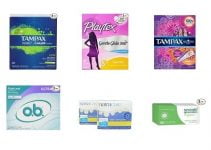
As a new parent, it’s almost impossible to predict when your child will be ready to start potty training and switch out from diapers, mainly because no two kids train alike.
Pull-ups help make the transition to underwear more comfortable, especially during nighttime. The stretchy sides are comfortable enough for your toddler to sleep in them by the age of three.
Disclaimer: This post might contain affiliate links. In case you buy through these links, we might receive a small commission, which helps us operate this website. Learn more here.
Other cues that let you know “when it’s time” include your child pulling on a dirty diaper, showing interest in using the washroom by themselves, having a dry diaper longer than usual, waking up dry from a nap, or letting you know when they need a change. This is the best time for pull-ups to step in and encourage their confidence while also preventing any bedtime accidents.
Should your child keep them on in the day?
Pull-ups are mainly designed to make visits to the toilet mess-free, so keeping them on during the day doesn’t have any apparent downsides. Instead, they tend to make nappy changes easier once your baby starts rolling, crawling, and moving around.
However, professionals and pediatricians often suggest skipping pull-ups during daytime potty training. This is because they have the same absorbency as diapers and may confuse your child if they should visit the toilet or not.
It is best to directly switch from diapers to underwear during the day, so the uneasiness points them to the washroom enough times to motivate them to stay dry. Another option could be a pair of training underpants with an extra absorbent layer to give them a sense of independence.
Why are pull-ups a good option?
 Some parents may argue that pull-ups are a little pricey, but they make the start of toilet training smooth and trouble-free for both the toddler and the parents. Here are a few ways pull-ups can lend a hand in raising your little one;
Some parents may argue that pull-ups are a little pricey, but they make the start of toilet training smooth and trouble-free for both the toddler and the parents. Here are a few ways pull-ups can lend a hand in raising your little one;
Quick and easy nappy changes
Pull-ups help when nappy changes become a difficult chore as your restless toddler only wants to crawl and roll about. They replace taping down the sides on your wriggling toddler with a quick pull up or down method even as they stand. Moreover, they feature rip-away sides that come in handy in case of leakage.
Make your little ones feel independent
Children pick up on the change much quicker than you would expect, and using pull-ups often encourages them to alert you whenever they have to go. Its effortless pull-down method is convenient enough to allow them to use the toilet on their own whenever they feel like it.
Leave room for accidents
It is often problematic for children to wake up and use the bathroom during the night at the initial stages of potty training, and your child may get discouraged if they wet the bed. Pull-ups help prevent that by giving them a profound sense of control until they’re ready to make the transition to underpants.
Less bulky
Their difference in design from diapers also enables them to be lightweight and more suitable to carry if you’re traveling or out of the house. Changing while you’re on the road is also not much of a hassle when switching to pull-ups.
Variety of sizes
New generation pull-ups are available to help out parents in nappy-changing from a very early age, starting from a size 3. This feature is put to best use when it comes to early-walkers. They also come in much bigger sizes than diapers as children tend to take about 8-10 months to be fully trained.
Which brand of pull-ups is best for your child?
Pampers Easy-Ups Training Pants
Like most of their products, Pampers is the brand to turn to for great bulk buying offers. The Dual Leak Guard Barriers and Easy-Tear sides not only offer great protection during day and night but are also available in 1-2 month supply purchases for toddlers weighing 16 lbs and up. The colorful designs also make potty training fun and easy-going.
Bambo Nature Dream Training Pants
For cautious parents that prefer non-toxic materials, the Dream collection from Bambo Nature is an excellent choice with its TCF fluff-pulp. These diapers feature a simple white look, soft feel, and a wetness indicator. However, according to a few consumers, they don’t handle leaks that well, and sizing is also not that inclusive.
Seventh Generation Free and Clear Training Pants

How should you discontinue the use of pull-ups?
When your little one is ready for nighttime training, start by initiating a habit of taking their pull-ups off first thing in the morning to use the bathroom. You should also notice if they are staying dry throughout the night. After a few days of this, a new routine should be adapted.
Slowly limiting liquids to an hour or two before bed can help avoid accidents during sleep. Furthermore, making sure they use the bathroom before going to bed is another good habit to establish.
Once they wake up dry consistently for a week or two, their pull-up days are over, and you may switch to underwear. It is important to remember that messes may still occur during the night. However, if these mishaps remain frequent by the age of six, it is best to consult a pediatrician.
Conclusion
The verdict remains that pull-ups share almost the same features as diapers while offering more convenience and ease of use. Thus, choosing to rely on them as a helping hand or not wanting to add any extras to your budget depends entirely on the parents.
While using pull-ups can significantly make an impact on your child’s potty training, they might not be the best choice when it comes to just restless nappy-changing. For the latter, an anti-roll changing mat could be a simpler and cheaper solution.





